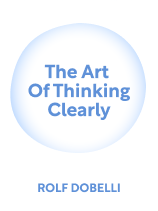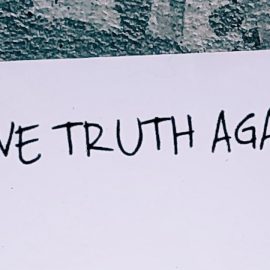

This article is an excerpt from the Shortform book guide to "The Art of Thinking Clearly" by Rolf Dobelli. Shortform has the world's best summaries and analyses of books you should be reading.
Like this article? Sign up for a free trial here .
What is Rolf Dobelli’s The Art of Thinking Clearly about? What is the key message to take away from the book?
In The Art of Thinking Clearly, Rolf Dobelli breaks down the most common logical fallacies that plague humanity. Logical fallacies affect everyone, are extremely difficult to avoid, and can hinder our decision-making ability. Dobelli encourages readers to improve their decisions by learning how to recognize these fallacies and how to work around them.
Here’s our review of The Art of Thinking Clearly by Rolf Dobelli.
About the Author
Rolf Dobelli is a Swiss writer and entrepreneur. Born in Lucerne, Switzerland, in 1966, Dobelli studied philosophy and business administration at college. He graduated with an MBA and PhD in philosophy from the University of St. Gallen, Switzerland in 1995.
Dobelli primarily wrote novels before stepping into non-fiction in 2011. The Art of Thinking Clearly was his first non-fiction book, and he hadn’t always intended to publish it. The book was originally a private list of fallacies he’d curated to help himself act logically. It was only after friends expressed interest in the list that he started publishing it in newspaper columns and eventually as a book.
Once it was published, The Art of Thinking Clearly catapulted Dobelli to international success. Since then, he’s written four other non-fiction books. The Art of Thinking Clearly remains his most well-known publication.
Dobelli connects to readers through his simple and anecdotal writing style. He cautions in the book’s introduction that he’s not an expert in his subject matter, though he’s spent years studying with experts. Dobelli instead views himself as a translator, taking complex psychological ideas and making them accessible to the general public.
In addition to writing, Dobelli co-founded getAbstract, a company that summarizes business content. He also founded WORLD.MINDS, a non-profit that unites science, business, and culture by inviting experts in these fields to share their ideas.
Connect With Rolf Dobelli:
The Book’s Publication
The Art of Thinking Clearly was originally published in German (under the name Die Kunst des klaren Denkens) in 2011 by Carl Hanser Verlag. It was translated into English in 2013 through Scepter, an imprint of Hodder & Stoughton. In 2014, a second edition was published through Harper Paperbacks, an imprint of HarperCollins, including an extensive bibliography and citations. For this guide, we’re using the 2014 edition.
Historical Context
The Art of Thinking Clearly was published in 2011, on the heels of an unprecedented period of expansion in psychological study. Since the 1980s, interest in psychology had grown steadily. The founding of groups like the Association for Psychological Science had allowed scientists to expand their borders by collaborating with fellow researchers in different fields and locations. Some of the fallacies Dobelli discusses were discovered during this time, and many more were expanded upon. The Art of Thinking Clearly made this information accessible to laypeople, capitalizing on the public’s curiosity and the pace of new discoveries in the field.
Intellectual Context
Dobelli wasn’t the only one to take advantage of the aforementioned increased interest in psychology. In fact, Dobelli was inspired to create his own list of fallacies after reading an early draft of Nassim Nicholas Taleb’s Antifragile, which was published in 2013. Other books, such as Thinking, Fast and Slow by Daniel Kahneman, published in 2012, also explored psychological fallacies to great success. However, Dobelli is unique in the breadth of his content. Most of his contemporaries focused on a few fallacies with a common root, while Dobelli explored 99 of the most common fallacies, including how they form and how to overcome them.
Dobelli admits in his introduction that the ideas contained in the book are not his own; rather, as we’ve noted, he acts as a translator between scientist and layperson. However, some people believed he drew too much from others’ ideas without giving adequate credit. In 2013, Taleb accused Dobelli of plagiarizing Antifragile, an early draft of which he’d given Dobelli several years before. While Dobelli argued that he’d referenced Taleb fairly, he updated later editions of the book with citations and a bibliography.
The Book’s Impact
The Art of Thinking Clearly was an instant success, entering Germany’s Der Spiegel bestseller list at number one and maintaining the position for 30 weeks. It was the overall bestselling non-fiction book in Germany and Switzerland in 2012. After the 2013 English translation was published, it became a top-10 bestseller in many other countries, including the UK, South Korea, and India.
Critical Reception
The Art of Thinking Clearly reviews were largely positive; many readers even consider The Art of Thinking Clearly to be required reading for those seeking to make logical decisions. They enjoy Dobelli’s straightforward approach and anecdotal style that make complex psychological ideas accessible to the layperson. Many readers also appreciated the book’s insights on overcoming the fallacies and said the information helped them avoid illogical thinking.
However, not all readers appreciated the book’s simplistic style. Some readers argued that the book was too simplified and didn’t provide enough nuance to give readers a firm understanding of the fallacies. In addition, some pointed to Dobelli’s alleged plagiarism to argue that he doesn’t introduce any original ideas.
Commentary on the Book’s Approach
As noted, The Art of Thinking Clearly originated as a personal list of fallacies Dobelli kept to encourage his own logical thinking. Thus, the book has a matter-of-fact tone and focuses on explaining each fallacy quickly and simply. This is also why Dobelli uses the most well-known examples to illustrate the fallacies, rather than creating his own: His goal was not to introduce new ideas to the field of psychology, but rather to give a quick and easy guide to established ideas.
Throughout the book, Dobelli uses “via negativa,” a method of problem solving in which instead of introducing steps to success (how to think logically), he tells you what to avoid (the logical fallacies). Since there’s no step-by-step method of thinking logically all the time, but research shows that certain problems with logic affect everyone, this method arguably works well for Dobelli’s topic.
Commentary on the Book’s Organization
The Art of Thinking Clearly has 99 short chapters without any overarching organization or thematic grouping. This is probably because of the book’s history as newspaper columns: Columns don’t need to build on each other, and they have strict length limits. However, in book form, this lack of organization can make the ideas feel disjointed.
In addition, there’s a great deal of repetition throughout the book. While Dobelli warns that this is the case—logical fallacies all stem from the brain, so they’re bound to overlap—some fallacies seem contrived, forced into a new chapter to reach the 99-chapter goal when they could work better folded into another chapter.

———End of Preview———
Like what you just read? Read the rest of the world's best book summary and analysis of Rolf Dobelli's "The Art of Thinking Clearly" at Shortform .
Here's what you'll find in our full The Art of Thinking Clearly summary :
- A detailed look at the most common logical fallacies that inhibit decision-making
- How to recognize and overcome these fallacies to make better decisions
- Why you value things for arbitrary reasons






